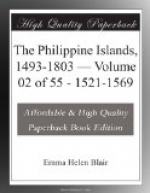[104] See note 43, ante, as to the cost of the fleet. The reference in the text is apparently to some Mexican mint or mine.
[105] This vessel was the “San Lucas,” commanded by Alonso de Arellano; see account of its adventures in “Expedition of Legazpi.”
[106] A reference to the relation sent to Felipe II by Legazpi—probably by the “San Pedro.”
[107] A measure for grain containing one-third of a fanega.
[108] An error naturally made, in those early days of acquaintance with the Philippines, since the island of Mactan (Matan), where Magalhaes was slain, lies near the coast of Cebu. According to the U.S. Philippine Gazetteer (p. 69), the archipelago comprises twelve principal islands and three groups, with one thousand five hundred and eighty-three dependent islands.
[109] Apparently meaning the “San Pedro,” which was despatched from Cebu by Legazpi on June 1, 1565. It reached Navidad on October 1, and probably arrived at Seville in May or June, 1566.
[110] The concha and blanca were ancient copper coins of the value of one-half and three maravedis, respectively. The coins above-mentioned evidently resembled these in size.
[111] The “San Geronimo.”
[112] Throughout this document, the statements and comments of the notaries will be enclosed in parentheses, to enable the reader more easily to separate the various letters and writs from one another.
[113] The caracoa is a large canoe used by the Malayan peoples—“with two rows of oars, very light, and fitted with a European sail, its rigging of native manufacture” (Dic. Acad.). According to Retana (Zuniga, ii, p. 513*), the word caracoa is not to be found in Filipino dictionaries.
[114] Referring to the rule of Sebastiao, the infant king of Portugal, and of his grandmother Catarina, regent during his minority.
[115] Javelins: the Portuguese word is azagayas, with which cf. assagai, the name of a like weapon among the Kaffirs of Africa.
[116] This phrase (meaning “nothing paid”) is no longer used in notarial documents. Sometimes when documents are legalized by the Mexican Legation at Washington, the fee is not paid there, but is to be paid at Mexico on presentation of the document there; the secretary of the Legation accordingly writes on it, No se pagaran derechos—perhaps a similar procedure to that noted in the text.—Arthur P. Cushing (consul for Mexico at Boston).
[117] This arose from the fact that the Portuguese navigated eastward from Europe to reach their oriental possessions, while the Spaniards voyaged westward. The reckoning of the Spaniards in the Philippines was thus a day behind that of the Portuguese. This error was corrected in 1844, at Manila and Macao respectively. See vol. i, note 2.
[118] Sevilla, one of the centers of Mahometan power in Spain, was besieged for more than two years (1246-48) by Fernando III of Castilla, who finally captured it. The expedition against Tunis here referred to was undertaken by Carlos I of Spain (1535). to restore Muley Hassan, the Mahometan king of Tunis, to his throne, whence he had been driven by Barbarossa, King of Algiers; the usurper was expelled, after a brief siege.




